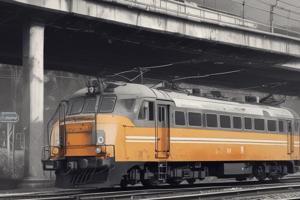Podcast
Questions and Answers
What is the primary benefit of a product layout?
What is the primary benefit of a product layout?
- Improved worker productivity
- Increased flexibility to handle a variety of products
- Reduced material handling costs
- Ability to produce large volumes efficiently (correct)
Which type of facility layout groups different workstations together based on the products they work on?
Which type of facility layout groups different workstations together based on the products they work on?
- Fixed position layout
- Process layout
- Cellular layout
- Product layout (correct)
What is the primary purpose of a combined layout?
What is the primary purpose of a combined layout?
- To maximize capacity utilization
- To improve material handling efficiency
- To optimize the layout for service facilities
- To increase production flexibility (correct)
Which of the following is NOT a key feature of a good plant layout?
Which of the following is NOT a key feature of a good plant layout?
Which type of facility layout is best suited for production of customized or low-volume products?
Which type of facility layout is best suited for production of customized or low-volume products?
What is the primary benefit of a service facility layout?
What is the primary benefit of a service facility layout?
Which type of layout is best suited for high-volume production of standardized products?
Which type of layout is best suited for high-volume production of standardized products?
Which of the following is a key factor in capacity planning?
Which of the following is a key factor in capacity planning?
What is the primary purpose of capacity utilization analysis?
What is the primary purpose of capacity utilization analysis?
Which type of layout combines the benefits of different layout types to achieve maximum flexibility?
Which type of layout combines the benefits of different layout types to achieve maximum flexibility?
Flashcards are hidden until you start studying
Study Notes
Types of Facility Layout
- Product layout: groups different workstations together according to the products they work on
- Process layout: groups workstations together according to the activities being performed
- Fixed Position/Stationary layout: product or project remains stationary, and workers, materials, and equipment are moved as needed
- Cellular or group layout: based on the group technology (GT) principle, suitable for manufacturing environments with large variety of products in small volumes
- Service Facility Layout: used in services such as banks and insurance companies
- Combined Layout: combination of different layouts
Advantages of Product Layout
- Low unit cost
- Labor specialization
- Low material handling cost
- High utilization of labor and equipment
- Established routing and scheduling
- Short processing time
Disadvantages of Product Layout
- Creates dull, repetitive jobs
- Poorly skilled workers may not maintain equipment or quality of output
- Fairly inflexible to changes in volume
- Highly susceptible to shutdowns
- Needs preventive maintenance
- Require large capital investment
Advantages of Process Layouts
- Can handle varied processing requirements
- Machines breakdown doesn't result in shutdown
- Equipment used is less costly
- Wide flexibility in production facilities
Disadvantages of Process Layouts
- In-process inventory costs can be high
- Challenging routing and scheduling
- Equipment utilization rates are low
- Material handling is slow and inefficient
- More space is required
- Longer processing time
- Backtracking may occur
Studying That Suits You
Use AI to generate personalized quizzes and flashcards to suit your learning preferences.




